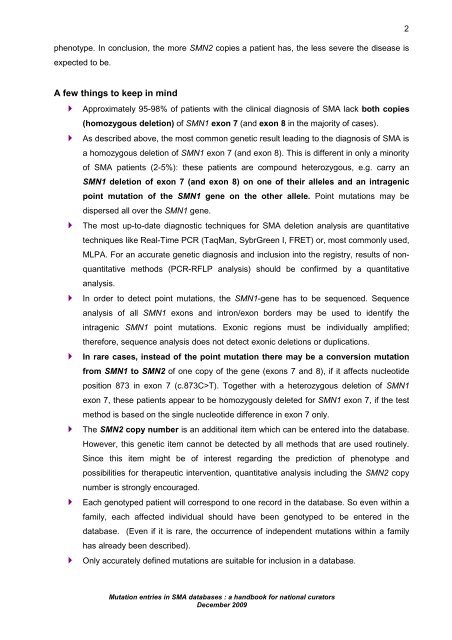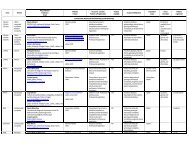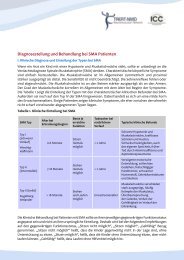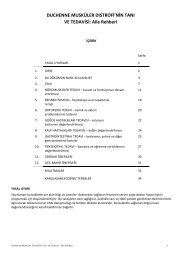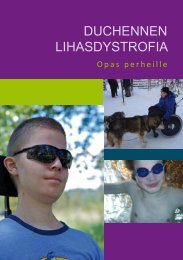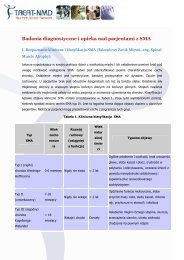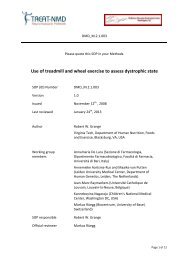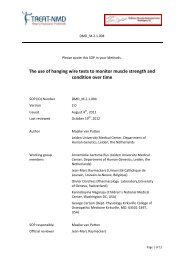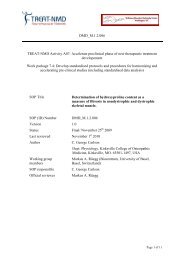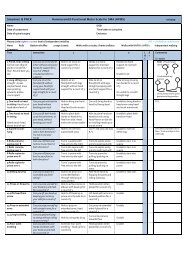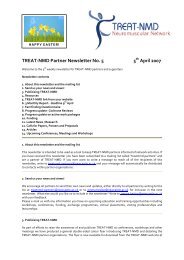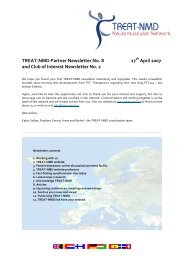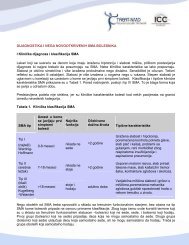A handbook on SMA genetics - Treat-NMD
A handbook on SMA genetics - Treat-NMD
A handbook on SMA genetics - Treat-NMD
You also want an ePaper? Increase the reach of your titles
YUMPU automatically turns print PDFs into web optimized ePapers that Google loves.
phenotype. In c<strong>on</strong>clusi<strong>on</strong>, the more SMN2 copies a patient has, the less severe the disease is<br />
expected to be.<br />
2<br />
A few things to keep in mind<br />
Approximately 95-98% of patients with the clinical diagnosis of <strong>SMA</strong> lack both copies<br />
(homozygous deleti<strong>on</strong>) of SMN1 ex<strong>on</strong> 7 (and ex<strong>on</strong> 8 in the majority of cases).<br />
As described above, the most comm<strong>on</strong> genetic result leading to the diagnosis of <strong>SMA</strong> is<br />
a homozygous deleti<strong>on</strong> of SMN1 ex<strong>on</strong> 7 (and ex<strong>on</strong> 8). This is different in <strong>on</strong>ly a minority<br />
of <strong>SMA</strong> patients (2-5%): these patients are compound heterozygous, e.g. carry an<br />
SMN1 deleti<strong>on</strong> of ex<strong>on</strong> 7 (and ex<strong>on</strong> 8) <strong>on</strong> <strong>on</strong>e of their alleles and an intragenic<br />
point mutati<strong>on</strong> of the SMN1 gene <strong>on</strong> the other allele. Point mutati<strong>on</strong>s may be<br />
dispersed all over the SMN1 gene.<br />
The most up-to-date diagnostic techniques for <strong>SMA</strong> deleti<strong>on</strong> analysis are quantitative<br />
techniques like Real-Time PCR (TaqMan, SybrGreen I, FRET) or, most comm<strong>on</strong>ly used,<br />
MLPA. For an accurate genetic diagnosis and inclusi<strong>on</strong> into the registry, results of n<strong>on</strong>quantitative<br />
methods (PCR-RFLP analysis) should be c<strong>on</strong>firmed by a quantitative<br />
analysis.<br />
In order to detect point mutati<strong>on</strong>s, the SMN1-gene has to be sequenced. Sequence<br />
analysis of all SMN1 ex<strong>on</strong>s and intr<strong>on</strong>/ex<strong>on</strong> borders may be used to identify the<br />
intragenic SMN1 point mutati<strong>on</strong>s. Ex<strong>on</strong>ic regi<strong>on</strong>s must be individually amplified;<br />
therefore, sequence analysis does not detect ex<strong>on</strong>ic deleti<strong>on</strong>s or duplicati<strong>on</strong>s.<br />
In rare cases, instead of the point mutati<strong>on</strong> there may be a c<strong>on</strong>versi<strong>on</strong> mutati<strong>on</strong><br />
from SMN1 to SMN2 of <strong>on</strong>e copy of the gene (ex<strong>on</strong>s 7 and 8), if it affects nucleotide<br />
positi<strong>on</strong> 873 in ex<strong>on</strong> 7 (c.873C>T). Together with a heterozygous deleti<strong>on</strong> of SMN1<br />
ex<strong>on</strong> 7, these patients appear to be homozygously deleted for SMN1 ex<strong>on</strong> 7, if the test<br />
method is based <strong>on</strong> the single nucleotide difference in ex<strong>on</strong> 7 <strong>on</strong>ly.<br />
The SMN2 copy number is an additi<strong>on</strong>al item which can be entered into the database.<br />
However, this genetic item cannot be detected by all methods that are used routinely.<br />
Since this item might be of interest regarding the predicti<strong>on</strong> of phenotype and<br />
possibilities for therapeutic interventi<strong>on</strong>, quantitative analysis including the SMN2 copy<br />
number is str<strong>on</strong>gly encouraged.<br />
Each genotyped patient will corresp<strong>on</strong>d to <strong>on</strong>e record in the database. So even within a<br />
family, each affected individual should have been genotyped to be entered in the<br />
database. (Even if it is rare, the occurrence of independent mutati<strong>on</strong>s within a family<br />
has already been described).<br />
Only accurately defined mutati<strong>on</strong>s are suitable for inclusi<strong>on</strong> in a database.<br />
Mutati<strong>on</strong> entries in <strong>SMA</strong> databases : a <str<strong>on</strong>g>handbook</str<strong>on</strong>g> for nati<strong>on</strong>al curators<br />
December 2009


